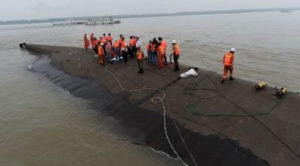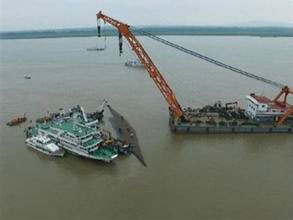At about 9:30pm on 1 June 2015, the Yangtze River cruise ship the Eastern Star 东方之星 capsized in fifteen-metre-deep water in Jianli County, Hubei province. It had been halfway through an eleven-day, 1500km journey from Nanjing to Chongqing via the Three Gorges, with 403 tourists, forty-six crew and five travel guides on board. The final death toll of the disaster was 442, making it China’s worst boat disaster in over six decades.
The twelve survivors recalled travelling through pounding rain and lightning, when the boat suddenly tilted to a ‘forty-five-degree angle’ and overturned in ‘about half to one minute’. Even if the boat had been equipped with enough life jackets and lifeboats, most passengers, in their cabins at the time, did not have enough time to react. Two hours later, the river patrol picked up Captain Zhang Shunwen 张顺文 and Chief Engineer Yang Zhongquan 杨忠权 from the water after the crew of another boat spotted them and called for their rescue. Of the other survivors, some swam ashore, some were saved after hours floating with life jackets on the river, and some were pulled out from air pockets inside the hull by rescuers.
The captain, who was taken into police custody, claimed that he was attempting to steer the boat but the wind was too strong. According to Xinhua, the Eastern Star sank so fast that it did not have time to send out a distress call. An angry public questioned why the captain didn’t do as other vessels on the river did and drop anchor after the maritime office issued a severe storm warning that afternoon.
While Chinese meteorologists later described the storm as a Force 12 cyclone, and authorities described the weather conditions as freakish and unpredictable, the public demanded closer scrutiny into the captain’s responsibilities, as well as the safety regulations, equipment and supervision on boats and into the management of shipping and tourism generally. The Eastern Star, which had been in service for nearly twenty years, had passed its annual inspections. Yet news reports revealed that a 1997 retrofit had left it with safety defects and as late as 2013, the Nanjing authorities for safety violations.
Following a familiar pattern, and as outrage grew, the central government ordered journalists to focus on the positive sides of the story, such as rescue efforts, and banned reporting by local journalists. Some foreign journalists too were blocked from entering the rescue site and barred from talking to relatives of victims. Authorities also muted criticism in public forums and censored negative comments in social media.
In December, six months after the crash, a sixty-member investigative team released their report into the incident, which they described as ‘an extraordinary serious disaster’. They attributed the tragedy to heavy rains and winds resulting from a rare weather phenomenon and asserted that the ship had in fact conformed to official safety criteria.
Forty-three people were held accountable including two crew members of the ship, executives of Chongqing Eastern Shipping Corp 重庆东方轮船公司, the owner of the Eastern Star, and maritime author-ities for their negligent management. The report recommended that the captain be investigated further but held that he could only be blamed for ‘insufficient knowledge’ and ‘in-adequate response’.




